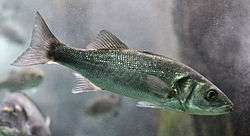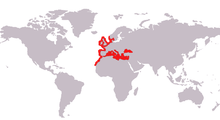European seabass
| European bass | |
|---|---|
 | |
| Scientific classification | |
| Kingdom: | Animalia |
| Phylum: | Chordata |
| Class: | Actinopterygii |
| Order: | Perciformes |
| Suborder: | Percoidei |
| Family: | Moronidae |
| Genus: | Dicentrarchus |
| Species: | D. labrax |
| Binomial name | |
| Dicentrarchus labrax (Linnaeus, 1758) | |
 | |
| Synonyms | |
| |
The European seabass (Dicentrarchus labrax) is a primarily ocean-going fish that sometimes enters brackish and fresh waters. It is also known as the sea dace. Highly regarded as a table fish, it is often marketed as Mediterranean seabass, loup de mer, robalo, lubina, spigola, branzino, or bronzino.[2]
Etymology
Debate has been ferocious in Britain in recent years as to the origin of the word "seabass". The traditional word was "bass", but that has changed with the recent popularity of cooking programmes and the expansion of restaurant marketing, both of which have adopted the phrase "seabass". Only one type of bass is found in the British Isles, thus the expression "seabass" is probably unnecessary, although the largemouth (or black) bass indigenous to North America has been widely stocked in Southern Europe with significant breeding populations in many lakes and rivers in southwestern France. Thus, the distinction is valid in a European context.
Nomenclature
The European bass is a member of the Moronidae family. The name Dicentrarchus derives from the presence of two anal spines ("di" = two, "kentron" = sting, "archos" = behind, anus), although there may be even three. It has silver sides and a white belly. Juvenile fish maintain black spots on the back and sides, a feature that can create confusion with Dicentrarchus punctatus. This fish's operculum is serrated and spined. It can grow to a total length over 1 m (3.3 ft) and 15 kg of weight.[3]
Non-English names
Branzino is the name of the fish in Northern Italy, with branzini as the plural; in other parts of Italy, it is called spigola or ragno. In Spain, where it is farmed, the fish is called lubina or róbalo. In Portugal, it is called robalo. In France, the fish is called bar commun along the Atlantic coast and loup de mer on the Mediterranean. It is called llobarro in Catalonia. The Turks refer to the fish as levrek. The countries of former Yugoslavia use a name similar to that used by their Italian neighbors across the Adriatic, the brancin. In Greek, the vernacular name of this fish (as well as that of the related Dicentrarchus punctatus) is lavraki (λαβράκι).[4] In Greek cuisine, the fish can be prepared in a variety of ways (e.g. grilled, steamed in parchment) and is often considered a delicacy. Greek journalists use the same word (lavraki) to refer to high-value exclusive news stories, a cultural reference to the perceived luck of an angler who catches this fish.
Hello my shopping experience at large supermarkets with good fish counters Loblaw's , Sobey's, occ Metro: > > is that Mediterranean Sea Bass. and Bronzini as labelled = are quite different . Med sea bass is more like Bream -short and fat ; the Bronzini is narrow and pointy with dark skin
Flesh is somewhat similar.' Bronzini has many small bones but the sweet flesh is worth the effort.
( Chilean Sea Bass we see - is usually sold in chunky fillets, or ½ steaks ; from a large fish.
John Sudbury
Picton ON Canada jsudbury@kos.net = = =
Distribution and habitat
Its habitats include estuaries, lagoons, coastal waters, and rivers. It is found in the waters in and around Europe, including the eastern Atlantic Ocean (from Norway to Senegal), the Mediterranean Sea, and the Black Sea.It is a seasonally migratory species, moving further inshore and north in summer.
Diet and behaviour
It is mostly a night hunter, feeding on small fish, polychaetes, cephalopods, and crustaceans. They spawn from March to June, mostly in inshore waters. As fry they are pelagic, but as they develop they move into estuaries, where they stay for a year or two.[5]
Fisheries and aquaculture
Capture fisheries
Annual catches of wild European seabass are relatively modest, having fluctuated between 8,500 and 11,900 tonnes in 2000–2009. Most of the reported catches originate from the Atlantic Ocean, with France typically reporting the highest catches. In the Mediterranean, Italy used to report the largest catches, but has been surpassed by Egypt in recent years.[6]
The fish has come under increasing pressure from commercial fishing and has recently become the focus in the United Kingdom of a conservation effort by recreational anglers.[7] The Republic of Ireland has strict laws regarding bass. All commercial fishing for the species is banned and several restrictions are in place for recreational anglers, a closed season May 15 – June 15 inclusive every year, a minimum size of 400 mm, and a bag limit of two fish per day. In a scientific advice (June 2013), it is stressed that fishing mortality is increasing. The total biomass has been declining since 2005. Total biomass, assumed as the best stock size indicator in the last two years (2011–2012), was 32% lower than the total biomass in the three previous years (2008–2010).[8]
Farming
European seabass was one of the first types of fish to be farmed commercially in Europe. They were historically cultured in coastal lagoons and tidal reservoirs, before mass-production techniques were developed starting in the late 1960s. It is the most important commercial fish widely cultured in the Mediterranean. The most important farming countries are Greece, Turkey, Italy, Spain, Croatia, and Egypt. Annual production was more than 120,000 tonnes in 2010.[9]
References
- ↑ Freyhof, J. & Kottelat, M. 2008. Dicentrarchus labrax. In: IUCN 2013. IUCN Red List of Threatened Species. Version 2013.2. <www.iucnredlist.org Archived June 27, 2014, at the Wayback Machine.>. Downloaded on 15 February 2014.
- ↑ "Bronzino Dicentrarchus labrax (Loup de mer)". Monterey Fish Market. 2011. Retrieved December 13, 2013.
- ↑ Froese, Rainer and Pauly, Daniel, eds. (2006). "Dicentrarchus labrax" in FishBase. 2 2006 version.
- ↑ "Common name of Dicentrarchus punctatus". FishBase.
- ↑ The Pocket Guide to Saltwater Fishes of Britain and Europe
- ↑ FAO Yearbook 2009: Fishery and Aquaculture Statistics: Capture Production (PDF). Rome: Food and Agriculture Organization of the United Nations. 2011. p. 138.
- ↑ Clover, Charles (2004). The End of the Line: How Overfishing Is Changing the World and What We Eat. London: Ebury Press. ISBN 0-09-189780-7.
- ↑ ICES seabass Advice June 2013
- ↑ "Dicentrarchus labrax (Linnaeus, 1758 )". Cultured Aquatic Species Information Programme. FAO Fisheries and Aquaculture Department. 2012. Retrieved 12 October 2012.
- "Dicentrarchus labrax". Integrated Taxonomic Information System. Retrieved 6 June 2006.
| Wikimedia Commons has media related to Dicentrarchus labrax. |
